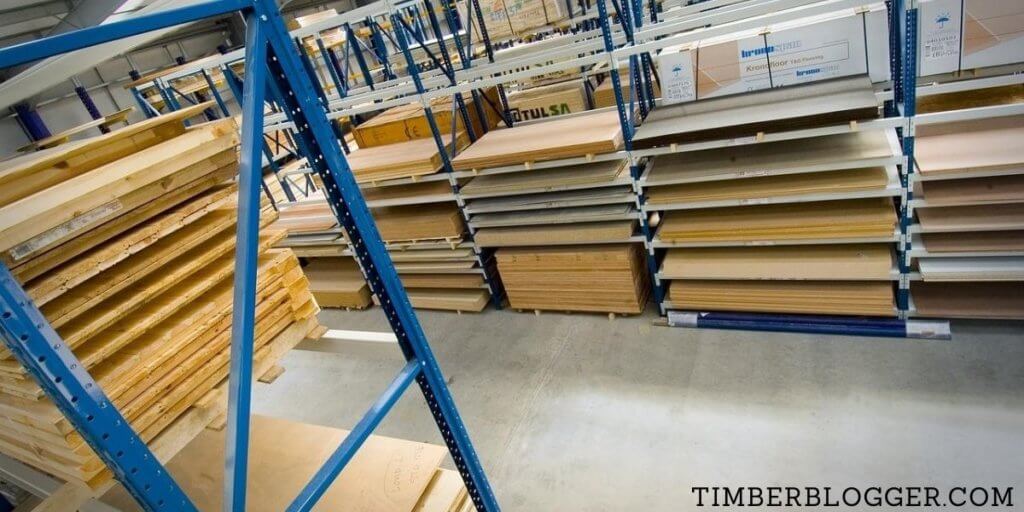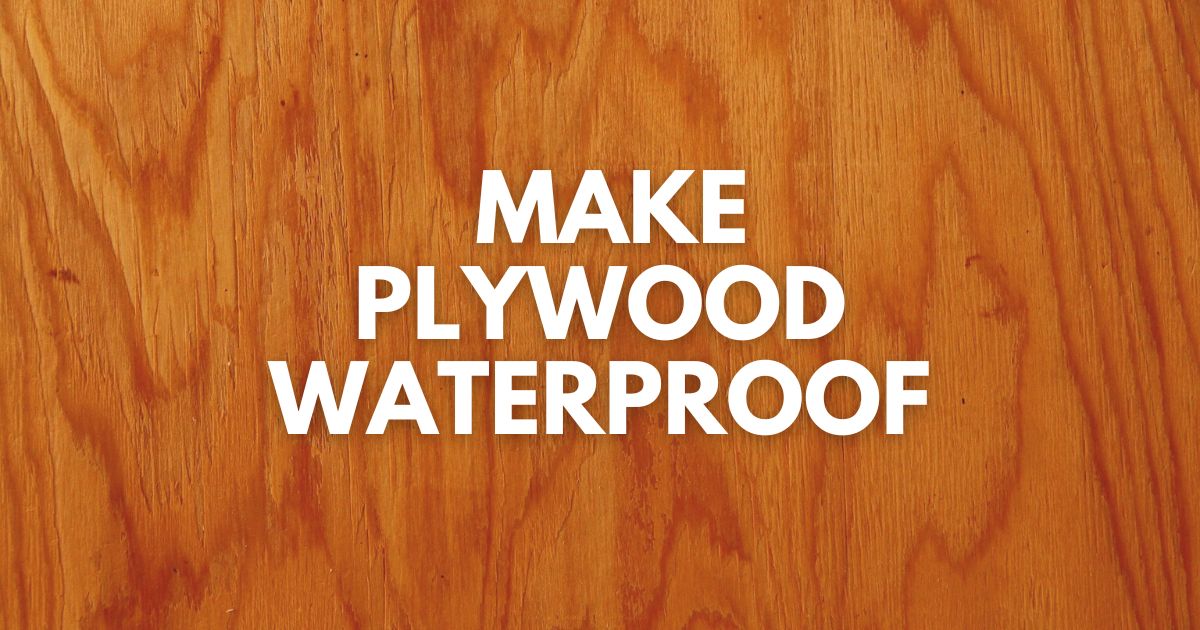Plywood is a versatile engineered material used for many purposes. It is easier to use than other construction materials. It is widely available in many-size thickness sheets. Plywood has been the most popular material for construction in the last few decades.
How is Plywood Made?
Plywood made with multiple thin layers of wood called veneers is glued with each other and pressed with the help of hydraulic pressure. So that everything sticks together and builds a strong plywood seat.
Methods to Make Plywood Waterproof
Plywood is more widely used in interior and exterior applications. But ordinary Plywood is not suitable for outdoor use as it needs to be waterproof or water resistant. We can make Plywood better water resistant by sealing it properly, which remains durable for a long time even in moisture.
There are a lot of methods of making Plywood waterproof. I will share simple and easy techniques with you.
Here are some simple methods to make Plywood waterproof.
1. Varnish Polish
Waterproofing Plywood With Varnish is super easy. Wood varnish is a clear, protective coating applied to plywood or wood surfaces to protect them from moisture, UV rays, and other outdoor elements.
These are the simple steps to apply the varnish correctly; follow them sequentially.
- Clean the surface thoroughly to remove any dirt or debris. Sand the surface of the plywood with sandpaper.
- Apply a coat of first coat of varnish to the plywood using a brush or roller to ensure even coverage. Allow the varnish to dry thoroughly for 24 hours.
- After the first coat has dried, sand the surface with 280-grit sandpaper. Light sanding makes the plywood surface smooth and gives the finest result.
- Apply a second coat of varnish to the entire surface of the wood.
- Allow the plywood to dry completely before being used in outdoor or high-moisture applications.
Varnishes are mainly of oil-based varnish and Water-based or Acrylic-based varnish. If you are using oil-based varnish, mix it with paint thinner, such as turpentine or if you are using water-based or acrylic-based varnish, then use clean water for mixing.
2. Paint
The most popular and easiest way is to waterproof plywood with paint. Although we cannot waterproof plywood forever through paint, for a few years, we can prevent the plywood from getting damaged by water.
Here are some simple steps to make plywood waterproof with paint.
- Cleaning and Sanding: Clean the plywood surface with mild detergent and water, If there is dust and stains on the plywood.
- Sanding: For a smooth surface, the plywood surface should be sanded with sandpaper. For larger jobs, a sanding machine would be fine.
- Fill all holes: Inspect the entire surface of the plywood before moving to the next step. If there is a hole or damage, make a paste by mixing wood sawdust and glue. All holes should be filled properly, and sand the entire surface with 100 or 220-grit sandpaper.
- Apply Primer: Apply the first coat of primer using a paintbrush or roller. Allow the primer to dry completely. Now, apply the second coat after the first coat.
- Sand again: Sand the surface again with fine-grit sandpaper to create a smooth surface.
- Apply Paint: Apply the first coat of paint to the plywood using a paintbrush or roller, starting with the edges. Keep the paint thin for the first coat. Allow the first coat of paint to dry completely, then apply a second coat.
- Allow the paint to dry completely before using or installing the plywood.
3. Polyurethane
Polyurethane forms a protective layer that keeps the surface of the plywood away from moisture and does not allow dust to settle on the plywood. Use a brush or roller to apply the two coats of Polyurethane to the surface of the plywood. Do this whole process in a dust-free environment.
Here are steps to make plywood waterproof with Polyurethane.
- Surface Preparation: Remove the old stain or finishing from the surface of the plywood by sanding it; use 100-grit sandpaper for sanding. If the surface is not previously stained, clean it with a damp cloth and allow it to dry.
- Apply Polyurethane: Apply a thin coat of Polyurethane with the help of a brush. Try to cover as many areas as possible at once.
- Clean and wait to dry: Wipe off excess polyurethane and allow the first coat to dry thoroughly for 24 hours.
- Apply final Polyurethane: Now we have to apply the second and final coat of Polyurethane.
Following the manufacturer’s instructions and allowing sufficient drying time between coats. It is also important to note that while Polyurethane can make plywood more resistant to water, it does not make it completely waterproof.
4. Epoxy Resin
Epoxy is another popular and modern way of sealing Plywood and making waterproofing. The epoxy forms a hard layer on the Plywood’s surface, making the excellent Plywood water-resistant and strong. The epoxy forms a thick layer, making it dent and scratch resistant.
Epoxy is a type of clear resin or glue made from a mixture of two components: a resin and a hardener. A chemical reaction causes the mixture to harden when the two components are mixed.
Epoxy comes in either spray or paint form. So you can use a spray or a brush depending on your epoxy type.
Here are steps to make plywood waterproof with Epoxy Resin.
- Sanding and Removing the Stain: Clean the surface of the plywood through sanding. Make sure your plywood surface is dry before moving to the next step.
- Apply Epoxy: Apply a thin coat of epoxy on the plywood surface and let it dry. After the first coat dries well, apply the second coat. Keep a gap of approximately 2 hours between the first coat and the second coat. Two coats of epoxy are sufficient, but if more coats are needed, then do it.
- Let the Project Dry: Epoxy forms a thick layer that takes 24 to 48 hours to dry.
5. Staining
Staining is another effective method of making plywood moderately water-resistant. Generally, Staining is used to enhance the beauty of the natural color of wood, but it is also used to seal the wood grain to stop penetrating moisture.
Here are the following steps to make plywood waterproof with Stain.
- Sanding the surface with fine-grit sandpaper to removes the Stain and makes a smooth surface.
- Wipe down the surface of the plywood with a clean, damp cloth to remove the dust left behind from sanding.
- Apply Pre-Stain Wood Conditioner to the plywood. Wood conditioner helps wood absorb stains more evenly.
- Using a paintbrush or a roller, apply the first Stain to the plywood in the direction of the grain.
- Wait a couple of hours, let the first coat dry, and apply a second coat
- Use a clean, dry cloth to remove any excess stains on the edges of the plywood.
- Allow the Stain to dry completely. It may take 24-48 hours for the Stain to dry correctly.
Which Grade of Plywood is Water-resistant?

Many types of Plywood available in the market are water and weather resistant. But we cannot say that Plywood, made of wood, will be 100% waterproof. Specific plywood grades are used for different purposes depending on the quality of the Plywood.
Moisture Resistant Grade
It is also called MR-grade plywood. This plywood is perfect for interior uses because it is resistant to moisture. It is treated with resins such as formaldehyde to resist humidity and water.
BWR Grade Plywood
BMR-grade plywood is known as “Boiling Water-Resistant.” These plywoods are more durable than MR grade. It can be used both in the interior and exterior. It is treated with phenolic resins to make it water-resistant. It can be used for all applications exposed to moisture, such as kitchen and bathroom doors.
BWP Grade or Marine Grade Plywood
The full name of BWP is “Boiling waterproof,” and it can be referred to as Marine Plywood. Which is more durable and expensive than MR and BMR grade plywood. This grade is primarily used for marine construction or all applications exposed to moisture and water over a long period, such as boat and house siding.
Does Plywood Hold Up in Rain?
No, if Plywood is not prepared for rain, it will swell and change shape within a few days. Common Plywood or ordinary Plywood is not ready for moisture. But we have other grades of Plywood which are rain resistant.
Conclusion
The construction material made of wood can never be entirely waterproof. Using some methods, we can make plywood more durable and withstand water and weather.
But if you want to use plywood in a place where there is an effect of moisture and weather. Therefore you should use something that is boiling water resistant (BWR grade plywood) or boiling waterproof (BWP grade plywood), along with the use of polish and paint to make it more durable.
Read other articles:
The Advantages And Disadvantages Of Wood Siding
Timber For Decking: Decking Guide


Comments are closed.